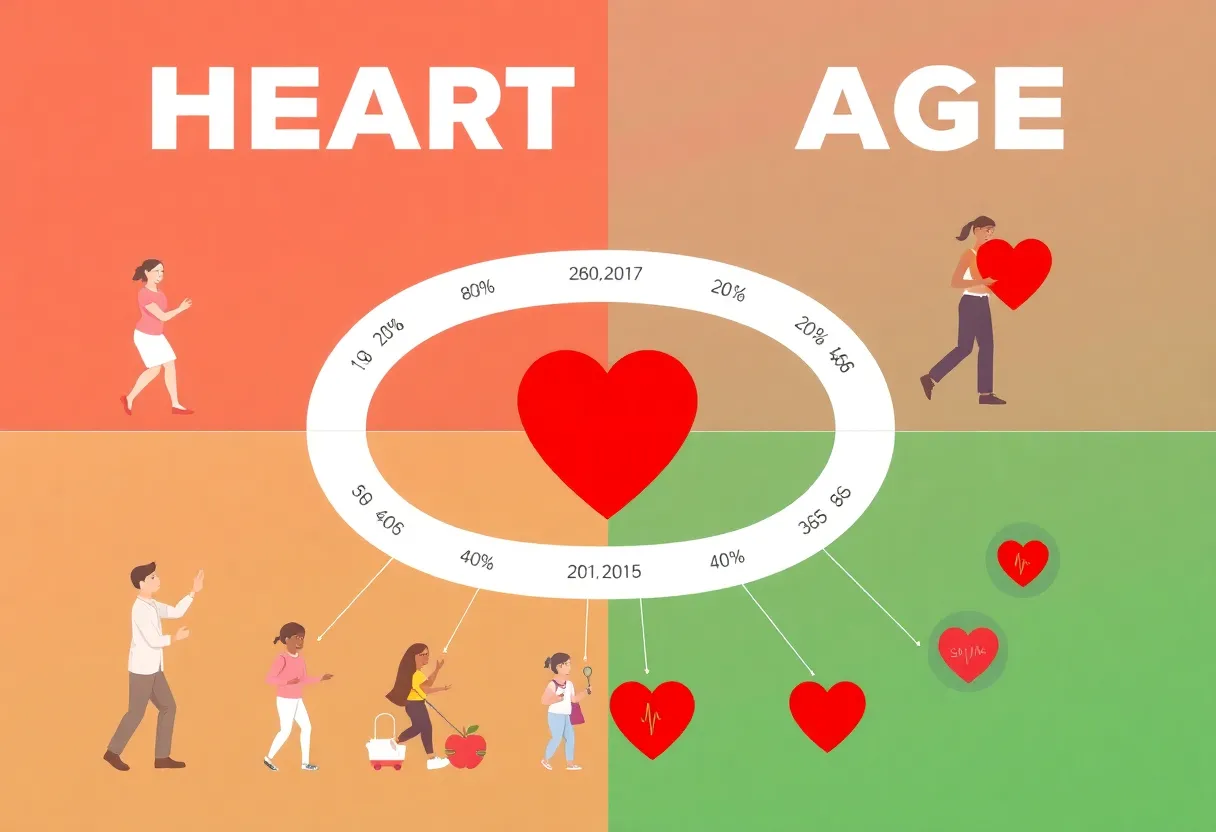News Summary
A new study from Northwestern Medicine reveals that many adults in the U.S. have a ‘heart age’ that significantly surpasses their actual age, indicating serious risks to cardiovascular health. The research shows disparities based on gender, education, and racial backgrounds, highlighting the need for enhanced heart disease risk communication. A newly developed online calculator aims to help individuals better understand their heart health, encouraging preventative behaviors. It is essential for healthcare providers to utilize this tool to increase awareness and improve patient outcomes related to heart disease.
Chicago, IL — Major Findings Show Most U.S. Adults Have a ‘Heart Age’ Older Than Their Actual Age
A recent study conducted by Northwestern Medicine reveals that a significant number of adults in the United States have a “heart age” that exceeds their chronological age by several years, in some cases over a decade. These findings highlight a growing concern about cardiovascular health and the need for better communication of heart disease risks.
Key Findings and Age Disparities
The study, which analyzed data from over 14,000 U.S. adults aged 30 to 79 without prior cardiovascular disease, found that, on average, women have a heart age of approximately 55.4 years compared to their actual age of 51.3 years. Men, on average, have a heart age of 56.7 years while their actual age is around 49.7 years. This suggests that many adults’ cardiovascular risk factors may be underrecognized.
The disparity is notably higher among specific demographic groups. About one-third of men with a high school education or less had a heart age more than 10 years older than their actual age, underscoring the influence of socioeconomic factors.
Racial and Ethnic Variations
The differences in heart age across racial and ethnic groups are particularly striking. Black men, for example, have an average heart age 8.5 years older than their chronological age, whereas Black women’s average is 6.2 years older. Hispanic men and women also exhibit significant gaps, with men having a 7.9-year difference and women about 4.8 years.
White men and women show smaller but still notable differences, with white men’s heart age about 6.4 years older and white women’s roughly 3.7 years. Asian men and women also show increased heart ages of 6.7 years and 2.8 years, respectively.
The Tool Developed for Better Risk Communication
The study introduces a free online calculator created by Northwestern scientists to estimate an individual’s “heart age” based on risk factors like blood pressure, cholesterol levels, smoking status, and diabetes presence. This tool aims to simplify understanding of heart disease risk, which traditionally has been expressed as a percentage—an approach that can be confusing for many patients.
While valuable, the calculator is intended to complement, not replace, clinical advice. Healthcare professionals are encouraged to use it as part of discussions about prevention strategies and risk reduction.
Implications for Public Health and Future Research
Heart disease remains the leading cause of death in the U.S., despite ongoing public health efforts. Many adults, especially those with lower incomes and education levels, may not be receiving adequate preventive care, increasing their risk of adverse outcomes.
The lead author of the study emphasizes that the heart age calculator might motivate individuals—particularly younger adults—to recognize their potential risk and adopt healthier behaviors early on.
Further research will explore whether presenting cardiovascular risk as heart age can lead to improved patient understanding and better health outcomes, including increased adherence to preventive measures and therapy.
Publication and Overall Goals
The study, titled “PREVENT Risk Age Equations and Population Distribution in US Adults,” is scheduled to be published in JAMA Cardiology on July 30, 2025. Its primary goal is to transform how healthcare providers communicate cardiovascular risk, making it more accessible and actionable for patients across diverse backgrounds.
Deeper Dive: News & Info About This Topic
HERE Resources
The Impact of Drinking Habits on Stomach Health
Tragic Forklift Accident Claims Life of Recent High School Graduate
President Trump Diagnosed with Chronic Venous Insufficiency
Calls for National Mesothelioma Registry Amid Rising Asbestos Cases
Woman Hospitalized After Liver Damage from Turmeric Supplements
Additional Resources
- The Washington Post: Heart Biological Age and Cardiovascular Disease
- STAT: Most Americans’ Hearts Older than Chronological Age
- Medical Xpress: Adults’ Hearts Older than Actual Age
- Today: Heart Age Study and Calculator
- BuzzFeed: Heart Cardiovascular Age
- Wikipedia: Heart Disease
- Google Search: Cardiovascular Disease
- Google Scholar: Heart Age Calculator
- Encyclopedia Britannica: Heart
- Google News: Heart Disease
Author: STAFF HERE WASHINGTON DC
The WASHINGTON DC STAFF WRITER represents the experienced team at HEREWashingtonDC.com, your go-to source for actionable local news and information in Washington, DC, and beyond. Specializing in "news you can use," we cover essential topics like product reviews for personal and business needs, local business directories, politics, real estate trends, neighborhood insights, and regional news affecting the area—with deep expertise drawn from years of dedicated reporting and strong community input, including local press releases and business updates. We deliver top reporting on high-value events such as the National Cherry Blossom Festival, Kennedy Center Honors, and the Washington Auto Show. Our coverage extends to key organizations like the Greater Washington Board of Trade and Destination DC, plus leading businesses in government contracting and technology that power the local economy such as Lockheed Martin and Amazon. As part of the broader HERE network, we provide comprehensive, credible insights into the dynamic landscape of the Washington metropolitan area.





